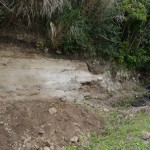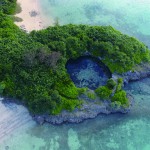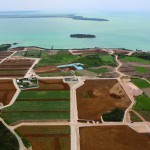【Designated by the City:Natural Monument (Geology)】Ubutakenaka Cave
It is located inside a land improvement district, about 500 m northeast of an intersection of the Sawada Route and the main farm road. On December 18, 1977, fossil pieces of Miyakonorojika were discovered by Professor Tomohide Nohara of the University of the Ryukyus and others. In March 1999, fossils of human teeth were also found. Ubutakenaka Cave is situated on the cliff side of an extensive collapse doline which takes a rice scoop shape. The formation of this lateral cave and a doline is important in terms of geology in Irabu Island.
It is considered that 1.7 to 1.2 million years ago, the Miyako Islands were connected to a continent where deer, elephants, wild boars, Ryukyukenaganezumi, habu and others came from.Between 50,000 to 60,000 years ago, upheavals actively took place, and the Miyako Islands emerged as islands of elevated coral reef. Then, about 20,000 years ago, the islands once again were connected to the continent. Around that time, various creatures and modern human beings are considered to have crossed over.
The cave is a valuable site in understanding the migration of human beings.
≫View on a Google Map
 宮古島アプリの綾道(あやんつ)トップページ
宮古島アプリの綾道(あやんつ)トップページ 宮古島アプリの綾道(あやんつ)の内容
宮古島アプリの綾道(あやんつ)の内容 宮古島の3つのルート
宮古島の3つのルート 宮古島市長のあいさつ
宮古島市長のあいさつ 宮古島文化遺産紹介
宮古島文化遺産紹介








